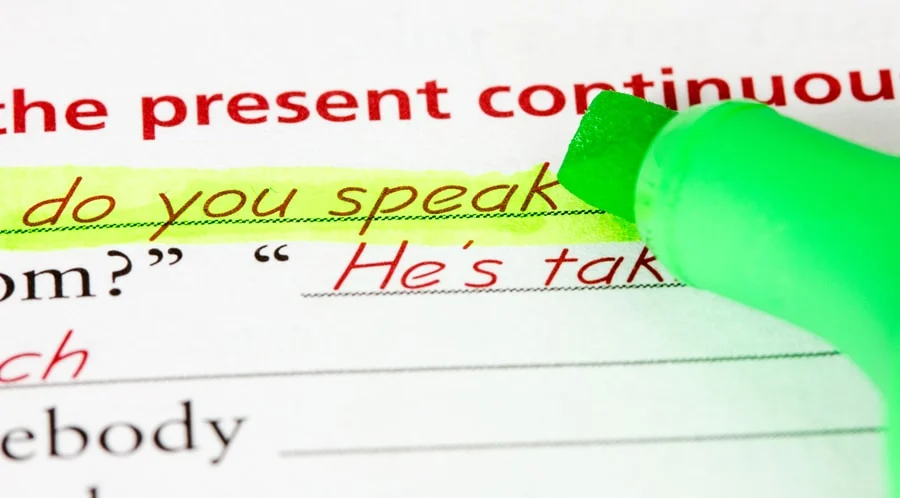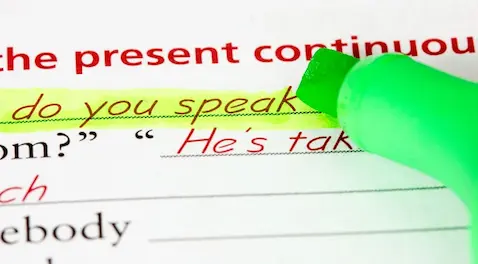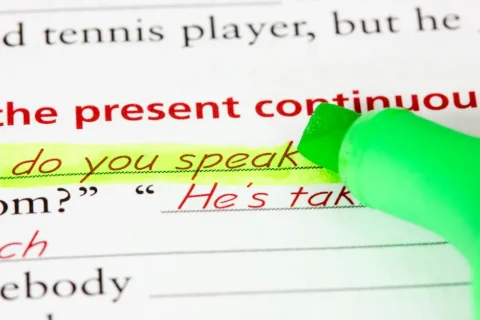What is a Tense?
Ask a teacher or learner to list the different tenses in English, and most will come up with something like this:
- present simple
present progressive
present perfect
past simple
past progressive
past perfect
future simple
future perfect
future progressive
This is one way of looking at tense, and can be very handy when it comes to categorising and sequencing language points that we want to teach. Many course books deal with tense in this way.
What are the tenses in English?
Strictly speaking, though, English only has two tenses, present and past, as in the following sentences:
- Present tense – I work
Past tense – I worked
In this way, tense refers to the location of an event in time, relative to some other time (usually the time of speaking). In other words, we use the present or past tense to indicate when an event or situation happens. We show the difference between present and past tense by a morphological change (a change in how we form the word):
- Present tense – talk
Past tense – talked
Present tense – speak
Past tense – spoke
Does English have a future tense?
Unlike in some other languages, there is no future tense in English. Instead, we use the modal auxiliaries will and shall, the present tense, and a few other forms to express the future. Here are some examples:
- I will buy it for you.
She’s going to leave now.
They are about to win the match.
The train leaves at 7.04pm.
We’re meeting tomorrow at about 11am.
Are tense and time the same?
We’ve just defined tense as “the location of an event in time”, or “when something happens”. With this definition we might think that we always use the present tense to talk about a present time, and the past tense to talk about a past time. But have a look at these sentences:
- “Politician hits out at protesters!”
“Hurry up ! The train leaves in 10 minutes.”
“If I won the lottery, I would buy a big house.”
The first sentence (a newspaper headline) uses the present tense, but to describe a past event. The second sentence uses the present tense to describe a future event. In the third sentence, we’re using the past tense to describe a future event, but only a hypothetical one – we use the past tense here to distance ourselves from the reality of the event.
So we have to be careful – there is not always a fixed relationship between tense and time.
What is an Aspect?
So, now we know that there are just two tenses in English, what do we do about all the different items in the list at the beginning that the teacher or learner might have come up with?
We call these aspects. While tense tells us when a situation occurs, aspect tells us how it occurs, or how it is viewed by the speaker, in terms of its frequency, its duration, and whether or not it is completed.
The examples above (I work and I worked) have a simple aspect (the present simple and past simple, respectively). Some people say that they have no aspect (more on this shortly), in which case these are examples of the present and past tense without any aspect.
What are the aspects in English?
There are three aspects in English:
- Simple aspect – this is the one we’ve just seen. With the simple aspect there is no indication of how the event occurs or how it is viewed by the speaker. That’s why some people say that there is, in fact, no aspect.
- Present simple – I work
Past simple – I worked
- Present simple – I work
- Progressive aspect – this is used by the speaker to indicate that a situation is in progress.
- Present progressive – I am working
Past progressive – I was working
- Present progressive – I am working
- Perfect aspect – this is used by the speaker to look back on an action from the perspective of the present.
- Present perfect – I have worked
Past perfect – I had worked
- Present perfect – I have worked
We can combine these last two aspects to make the present perfect progressive (I have been working) and the past perfect progressive (I had been working).
Aspect and the speaker’s interpretation
We said above that aspect is used by the speaker to show how she views a situation, in terms of frequency, duration and completion. Another way to put this is that a speaker uses aspect to get across her interpretation of what she is saying – her attitude to time. This can be something very personal – it doesn’t have to be based on fact, but can instead be based on the speaker’s perception of the event.
Here’s an example of what we mean by this. The best man at a wedding stands up during the meal at the reception, knocks his fork against a champagne glass to call for silence, and says:
- “I propose a toast.”
In this situation, the proposing of the toast is happening now. So if it’s happening now, why does he use the simple aspect and not the progressive aspect? After all, we said above that the progressive aspect shows that something is in progress. The answer is that it doesn’t need any interpretation from the speaker – it’s obvious that it is happening now, because he is the best man, he has just stood up and called for silence, and it is clear to everyone present that now is the moment of the toast.
Here’s another example:
- “Where do you live?”
“I’m living in Spain.”
Why doesn’t the second speaker reply in the same aspect as the first speaker? The second speaker chooses the progressive aspect to convey her personal interpretation of the situation – she sees her situation as more temporary – something that’s in progress at the moment, but may not be forever. The two sentences “I live in Spain” and “I’m living in Spain” are factually the same, but the situation needs some interpretation from the speaker – she wants to get across that this situation is in progress but is not permanent.
For the next example, compare these two sentences:
- “I sit here.”
“I’m sitting here.”
With the first sentence, no interpretation is needed. The listener is left in no doubt as to what the speaker means. With the second one, the speaker has added his interpretation to the sentence with the progressive aspect to show that it’s his seat at the moment, but he is not claiming ownership of the seat for now and all time!
Finally, have a look at these sentences :
- “I steal pens.”
“I’m stealing your pens.”
“I’ve stolen your pens.”
Again, the first sentence doesn’t need any interpretation and so the speaker uses the simple aspect. In the second sentence, the speaker deliberately wants to show that the action is in progress at the moment, and there might be any number of reasons why the speaker chooses to share this information with his pen victim.
In the final sentence, the speaker chooses the perfect aspect because he wants to relate the action to the present time. His interpretation of the event is that it is finished, but has some relevance in the present. He could have chosen to use the simple aspect and say “I stole your pens”, but this would have conveyed a different interpretation, one that we can assume he didn’t want to convey.








8 comments
shoshana
the best explanation ever
Nicholas Funk
One of the best. Very impressive.
Anointing
Nice teaching
Meena gul
It’s really helpful.
Marielle
Great explanation!! Thank you so much! I’m studying to be a teacher . Could you recommend me some great books and websites or other resources you find very useful, please?
Farhad
Very good knowledge about English grammar.
Rabia Azmat
Very helpful and impressive!! Thanks
Elizabeth
Super helpful! I’m trying to understand aspect in Bulgarian, and this explanation about English helped a lot! I also speak FR and DE, so I have a reference for “English doesn’t have a future tense.” I’d never noticed!